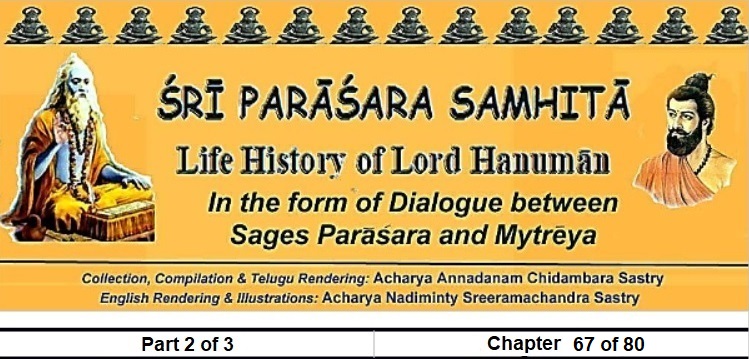
67th Chapter (Sapţaşaşţitama Paţalah)
“The Story of the Procedures of the Regular Ritualistic Activities”
(Nityakarmavidhi Kathanam)
श्रीपराशरः
मुने शृणुष्व वक्ष्यामि नित्यकर्मविधिक्रमम्
यस्य स्मरणमात्रेण मन्त्रास्सिध्यन्ति सर्वशः।। 1
Śrī Paraāśara:
“Oh! Great Sage! Mytrēya! I am telling about the procedures of the Regular Ritualistic Activities (Nityakarmavidhi). Listen. There will be achievement of mantra everywhere just by its recitation. (1)
समाधानं गुरुध्यानं शास्त्रोक्तविधिपूर्वकम्
प्रथमं देवताध्यानं स्तोत्राणां पठनं ततः।। 2
Procedure
One has to nicely meditate upon the guru (gurudhyāna) as laid down in the scriptures. First, meditation upon the God (dēvatādhyāna) and then recitation of the laudatory holy hymn (stōtrapaţhnam), has to be done. (2)
शौचकर्म तृतीयं स्यात् चतुर्थंं दन्तधावनम्
जलावगाहनस्नानं मन्त्रस्नानं ततः परम्।। 3
The third action is attending to the nature’s calls (saucakarma), followed by the fourth, that is cleaning teeth (dantadhāvanam). Then is performing bath by submergence, followed by mantra bath. (3)
नित्यसंध्याविधिश्चैव मन्त्रसंध्या ततः परम्
भूशुद्धिर्भूतशुद्धिश्च मातृकन्यास एव च।। 4
Then is the nityasandhyāvidhi (regular obligatory act for all those wearing the sacred thread) – cleansing Earth (bhoośuddhi), cleansing off creatures (bhootaśuddhi), basic systematic touching of body parts (mātrukānyāsa) etc. (4)
कर्तव्याश्च जपस्यादौ जपेदङ्गमनुं ततः
ततः प्रधानमंत्रं च जपेद्यत्नादतंद्रितः।। 5
These are to be performed before mantra recitation. After these the ańgamantra (bodily mantras = touching limbs) have to be recited. After that, with an undisturbed mind, the main (of the desired God) has to be recited. (5)
ततो जपसमाप्त्यन्ते होमपूजाविधिद्वयम्
होमान्ते पूजनं श्रेष्ठं पूजान्ते होम एव वा।। 6
The Rituals
After completing the japa, the fire-sacrifice method and worship method is stipulated. Best is worshipping after performing the fire-sacrifice; it can be done the other way too. (6)
तद्वैपरीत्ये नो दोष इत्युक्तं मन्त्रवेदिभिः
जपात्च्छ्रेष्ठतरं विद्धि तर्पणं मुनिसत्तम।। 7
Mantra experts say that it is no mistake to perform any other act after the worship and fire-sacrifice. Oh! Great sage Mytrēya! Know that water pouring (tarpaņa) is better than recitation. (7)
तर्पणादुत्तमं विद्धि होमं चैव विशेषतः
होमाच्छ्रेष्ठतरं लोके विद्धि ब्राह्मणभोजनम्।। 8
Know that fire-sacrifice is especially far better than tarpaņa. Far better than such a fire-sacrifice is offering ritualistic meals to śtōtriyas (those eligible to perform rituals and other karmas) in this mundane world. (8)
मन्त्रोपदेशगुरवस्सर्वोकृष्टा जगत्त्रये
स्वर्णालंकारवस्त्रैश्च दक्षिणागन्धपुष्पकैः।। 9
The guru (spiritual preceptor) is the highest regarded person everywhere. They are, with gold ornaments, new clothes, offering of gifts, sandal and flowers, (9)
पूजनीयाः प्रयत्नेन तदानन्त्याय कल्पते
सर्वेषामेव मन्त्राणां अयमेव विनिर्णयः।। 10
Are worthy of worship. Such a worship of the guru gives unlimited fruits. This is the stipulation for all the mantras. (10)
मन्त्राणां वीर्यसिद्धयर्थं पव्म्चशुद्धिरुदीरिता
पव्म्चशुद्धिं विना मन्त्रो न सिध्यति जगत्त्रये।। 11
Five fold-Purification (Pańcaśuddhi)
The fivefold-purification (pańcaśuddhi) is stipulated for envigouration of any mantra. Nowhere do the mantras fructify without pańcaśuddhi. (11)
जपतर्पणहोमाश्च द्विजसंतर्पणं तथा
गुरूणां दक्षिणा चेति पव्म्चशुद्धिरुदाहृता।। 12
The five fold-purification (pańcaśuddhi) are –recitation of mantra, tarpaņa, fire-sacrifice, offering meals to śtōtriyas and offering gifts to the guru are told as the pańcaśuddhis. (12)
स्त्रीविद्यानां च सर्वेषामन्तेष्वङ्गमनून्जपेत्
पुंविद्यानां च सर्वेषामादिष्वङ्गमनून्जपेत्।। 13
Ańgamantras must be performed for all woman-related (of Mother Goddess) mantras. The ańga mantras have to be performed before everything else, in case of male (masculine Gods) mantras. (13)
आत्मजप्येषु मन्त्रेषु स्वाभिमानात्सदा मनुः
प्रधान इति विख्यातः तदन्ये ह्मङ्गतां गताः।। 14
Among all the mantras recited by a person, the one most liked by him/her is the main mantra –pradhāna mantra. All other mantras are known as ańgamantras (the body of mantras). (14)
तदीयानां च चक्राणामपि मन्त्रक्रमेण वै
अंगप्रधानभावेन पूजाविधिरुदाहृतः।। 15
The yantra (amulet) to go with a given mantra has to be accepted as per the order of the mantra. The order of worship is stipulated based on the main feature of the body-part for such a mantra. (15)
मन्त्रं यन्त्रं तथा तन्त्रं देवतानुग्रहा£थना
त्रीण्यप्यवष्यं सेव्यानि यन्त्रं तेषु प्रशिष्यते।। 16
The Yantra (Amulet)
The three – yantra, mantra and tantra (rituals) – are worthy of employment definitely for securing benevolence of Gods. Among these the yantra is special. (16)
यन्त्रं मन्त्रमयं प्रोक्तं मन्त्रात्मा देवतेरिता
पुरा भगवताप्युक्तं तन्त्रे सम्मोहनाह्नये।। 17
The yantra is said to be full of mantras. The soul of the mantra is the God (dēvata). The Lord Himself told this earlier in the sammōhanatantra (captivating ritual method). (17)
देहात्मनोर्यथा भेदो मन्त्रदैवतयोस्तथा
तस्मात्पठेन्महामन्त्रं लिखित्वा तत्र पूजयेत्।। 18
The difference between the God and the mantra is similar to that between the soul and body. Hence the great mantra has to be recited. It has to be written into a yantra and worshipped. (18)
विना चक्रे चरेत्पूजां देवता न प्रसीदति
तस्माद्यत्नेन कर्तव्यं मन्त्राणां चक्रपूजनम्।। 19
Benevolence of God does not accrue, unless worshipped without drawing a yantra. Hence, a yantra has to be especially carried out for recitation of mantras. (19)
मन्त्रस्यैकस्य वा मनोरनेकस्यापि वा मनोः।। 20
Worship of the yantra is mandatory whether it is one mantra or a body of mantras. (20)
जपानुष्ठानकाले तु प्रत्यहं मंत्रवित्तमः
भूशुद्धिं भूतिशुद्धिः च बाह्याभ्यंतरमातृकम्।।
सकृष्देव प्रकुर्वीत न्यासं चापि यथाविधि।। 21
The medium (bāhyātara) base-body touching routine (mātŗkānyāsa) has to be performed only once along with purification of Earth and the creatures, as stipulated, daily during the mantra recitation time. (21)
प्रतिमाचक्रलिंगादिसालग्रामािदपूजनैः
पूजयेत्स्वेष्टदेवस्य त्वेकस्यावरणेन च।। 22
Only one round of worship has to be performed to the desired deity in the form of an idol or an amulet or abstract form (linga) or a fossilized iconic form (sālagrāma). (22)
नान्यावरणपूजेति कथितं रुद्रया स्वयम्।। 23
It was told by Śiva himself that there is no other concealed worship. (23)
चंद्रसूर्योपरागेषु ह्यर्थोदयमहोदये
संक्रांतिषु व्यतीपाते जपित्वा विधिना मनुम्।। 24
After completing the mantra recital during solar and lunar eclipses or half-raises (raise of just a half of the disc of Sun and Moon – as on the no-moon day and Sunday in the Indian lunar months puşya (10th) and māgha (11th), śravaņastar constellation, vyateepāta yoga (inauspicious period in each Hindu lunar month), mahodaya (long morning), transmigration phases of different zodiac or moon signs, (24)
पायसापूपहविषा पुष्पैः त्रिमधुना प्लुतैः
तण्डुलैस्तिलमिश्रैर्वा होमकर्म समाचरेत्।। 25
The fire-sacrifice has to be offered with pudding – sweet rice cooked in milk, fried rice cakes, fire-sacrifice items, flowers dipped in the three sweeteners (trimadhu= honey, sugar and ghee) along with sesame seeds and rice mixture. (25)
एकवारं जपेद्यस्तु स कोटिगुणितं लभेत्
सकृद्धोमविधानेन कोटिहोमफलं लभेत्।। 26
Reciting in the above manner is equal to doing so 10 million (kōţi) times. Performing fire-sacrifice (in the above manner) once is equal to performing fire-equal with10 million golden sovereigns. (26)
आत्मशक्त्यनुसारेण गुरुपूजापि दक्षिणा
अनन्तरंफलदा प्रोक्ता इत्येवं मुनयो ब्रुवन्।। 27
It was said by great seers, that doing so along with worship of the guru and offering gifts to the guru (gurudakşiņa) to one’s capacity, gives endless fruitful results. (27)
अन्यद्विशेषं वक्ष्यामि शृणुष्व मुनिपुंगव! 28
Oh! Sage Mytrēya! I am telling another special thing. Listen. (28)
।। अस्य श्री आव्म्जनेयानुष्टुभ्महामन्त्रस्य। प्रजापति
ऋषिः। गायत्रीछन्दः श्रीहनुमान्देवता। मर्कटेष इति बीजं।
अच्युत इति शक्तिः। कपिराज इति कीलकं। मम
श्रीहनुमत्प्रसाद सिद्धयर्थे जपे विनियोगः।। (मूलमन्त्रेण
करशुद्धिव्यापकन्यासं च कुर्यात्।।) 29
Śrī Āńjanēyānuşţubha Mahāmantra
For this Śrī Āńjanēyānuşţubha Mahāmantra, with Prajāpati (Creator Brahma’s son, as the lord) is the sage, Gāyatree is the metre, Śrī Hanumān is the lord, Mārkatēśa (lord of monkeys) is the base letter – beejam, Acyuta (Goddess) is the power, kapirāja (king among the monkeys) is the key, being used (viniyoga) for the benevolence of Śrī Hanumān; hand purification (karaśuddhi) and extensive body touching (vyāpakanyāsa) to be carried out with the base mantra. (29)
ध्यानम्
हयकपिगरुडास्यं क्रोडसिंहासनं च
दशभुजपरिघा हिखड्गखट्वांगपाशम्
गिरिकुलिशत्रिशूलं मौसलं चांकुशं च
घृतकरवरमुष्ट्रं प्रेतसंस्थानभूषम्।। 30
Dhyānam (Meditation)
The one with the faces of horse, eagle, wild boar and lion; the one holding with ten hands a snake, a sword, a leg of a stringed cot, a rope lasso, a hill, a diamond weapon, a trident, a pounding pole, an elephant goad and others; the one having a camel as a vehicle, the one having the death abode as ornament, (30)
अरुणवदनरूपं रक्तमाल्यांगकांतिम्
स्मरति रिपुजयार्थं सर्वसम्पत्समृद्धयै।। 31
The one with a red mouth, the one having radiant body due to the red ornamental chains worn, such a Hanumān I meditate upon for achieving all the wealth and victory over all the enemies. (31)
मनुः
मर्कटेश महोत्साह सर्वशोकनिवारक
शत्रून्संहर मां रक्ष श्रियं दापय मे प्रभो
अयुतं तु पुरश्चर्यां दशांशं तर्पयेद्बुधः
तद्दशांशं हुनेत्पश्चात् पायसं मधुमिश्रितम्।। 32
The Seven-Mantra-Souled Knowledge Base
Oh! Lord of momnkys! One with lots of enthusiasm, remover of every type of sorrow, Oh! Hanumān! Destroy all my enemies, protect me and grant me all riches (happiness, wealth and auspiciousness).
The above mantra has to be repeated 10,000 times. One tenth of it has to be tarpaņa. Then one tenth of it has to be performance of fire-sacrifice. Such a fire-sacrifice has to be performed with rice pudding (pāyas) mixed with honey, (32)
उपासना कृता पूर्वं बहुभिर्मुनिसत्तमैः।। 33
Many great sages followed this mantra earlier. (33)
अनुष्टुभमिदं श्रेष्ठं आव्म्जनेयमनुं मुने।।
सप्तकोटिमहामन्त्रश्रेष्ठश्रेष्ठतरं विदुः।। 34
Oh! Sage Mytrēya! All know that this anuśţup metre mantra of Hanumān is the best among the 70 million Mantras. (34)
सप्तमन्त्रात्मिका विद्या पव्म्चवक्त्रहनूमतः
सप्तकोटिमहामन्त्रजाले श्रेष्ठेति नारदः।। 35
Seer Nārada said that, among the 70 million mantras, this code of the seven-mantra-souled (saptamantrātmika knowledge base) of Hanumān is the best. (35)
सप्तमन्त्रस्थवर्णानां षण्णवत्युत्तराशीतिः
एकैकमक्षरं प्रोक्तं एकैकमनुसंज्ञया।। 36
Each of the letter present in this 196-lettered seven mantras, is itself a mantra, it is said. (36)
ऋषिन्यासश्च देवश्च छन्दोध्यानमुपासना
एकैकाक्षरमन्त्राणामेते सर्वे समास्स्मृताः।। 37
The seer, the nyāsa (orderly body part touching), ruling lord, metre, meditationand practice were said to be the same for all these one-lettered mantras. (37)
सप्तमंत्रात्मिकातुल्या विद्या नास्ति जगत्त्रये
हनुमत्सदृशं दैवं न भूतो न भविष्यति।। 38
There is now knowledge-base (vidyā) in the three worlds that is equal to the saptamantrātmika knowledge base. There was no God in the past, nor there will be in the future, equal to lord Hanumān. (38)
सप्तकोटिमहामन्त्रसारं संगृष्ह्य शम्भुना
सप्तमन्त्रात्मिका विद्या क़ृता लोकहिताय वै।। 39
This seven-mantra-souled knowledge base was made by lord Śiva for the well-being of the world by taking the essence of the 70 million mamtras. (39)
अतो विद्यामिमां ये तु पठंति द्विजसत्तमाः
सप्तकोटिमहामन्त्रान् ते पठंति न संशयः।। 40
So which ever qualified (śrōtriya) person recites this saptamantrātmika, is equal to the one that recited the school of 70 million Mantras. (40)
अन्यं विशेषं वक्ष्यामि होमकर्मणि चोदितम्
स्वाहाकारं तु होमांते पठेद्विद्वानतंद्रितः।। 41
End Words of Holy Services
I am telling about another specialty that was told for the homakarma. A wise person has to tell the word ‘swāhā’ (the denouement indicating the end of the mantra) without any hesitation. (41)
तर्पयामीति वचनं तर्पणांते समुच्चरेत्
होमतर्पणयोरंते जयद्वन्द्वं पुनःपुनः।। 42
After the tarpaņa (water pouring), the word ‘tarpayāmi’ (I am offering to the God). After hōma and tarpaņa, the twin-victory words have to be said again and again, i.e., Jaya Jaya, Jaya Jaya … (42)
मन्त्राणां बलसिद्ध्यर्थं यशश्श्रेयोपसिद्धये
इत्यागमविधानज्ञैः कथितं मुनिसत्तमैः।। 43
Best of seers knowledgeable in the science of worship (āgamaśśstra) have told earlier that, for imparting power, fame and welfare to the mantra, one has to say so. (43)
अन्यं विशेषं वक्ष्यामि पल्लवार्थं मुनीश्वर
सर्वेषामपि मंत्राणां मंत्रांते पल्लवं न्यसेत्।। 44
Oh! Great sage Mytrēya! I am telling about another specialty about services or action-indicator words (pallava). Pallava has to be told at the end of every mantra. (44)
केषांचिदेव मंत्राणामादौ पल्लव ईरितः
आदावंते च केषांचित् पल्लवद्वयमिष्यते।। 45
For some mantras the pallava has to be told at the beginning. For some, it has to be said twice, once at the beginning and once more at the end. (More details about the pallavas are given in the 19thPatala in Part 1). (45)
पल्लवद्वयसंबंधात् प्रत्यवायो न विद्यते
आद्यंतपल्लवस्पर्शःमंत्राणामुत्तमोत्तमम्।। 46
In the methodology of tantra, it is not an error to tell just two pallavas (exclamations associated with services). It is best of all, to tell them at the beginning and at the end, the best in tantra methodology. (46)
महाभैरवकल्पे च संप्रोक्तं मुनिपुंगवैः
सर्वेषामपि मंत्राणां पल्लवेन त्वपि स्फुटम्।। 47
This fact was mentioned so by best of seers earlier in the work entitled Mahābhairavakalpa. (47)
होमार्थे षट्प्रयोगार्थे योजयेत्पल्लवं पुनः
पुनः पल्लवसंयोगात् प्रत्यवायो न विद्यते।। 48
As regards the fire-sacrifice, for the six uses (śaţprayōga), service exclamation (pallava) has to be composed again, which in no way results in a withdrawal (pratyavāyam) sense. (48)
जपतर्पणहोमव्म्च द्विजसंतर्पणं तथा
चतुर्विधमिदं ब्रह्मन् मंत्रांगं परिकीर्तितम्।। 49
Caution of Methodology
Oh! Brahmarşee (Seer having the knowledge of the Supreme Being – Brahman)! Famous as the mantrāńgas (parts of the mantra) are the recital (japa), water pouring (tarpaņa), hōma (fire-sacrifice) and gifting feast (samārādhana) for the śrōtriyas (those eligible to undertake rituals). (49)
अंगभङ्गो भवेद्यत्रतत्संख्याद्विगुणो जपः
सर्वतंत्ररहस्याद इत्युक्तं मन्त्रवेदिभिः।। 50
If any part of the mantrāńga is not performed, recital (japa) has to be carried out twice that number. This is the secret as told for all the ritual acts (sarvatantra) by mantra experts. (50)
सालग्रामे तथा लिंगे पूजयित्वाथ देवताम्
उभाभ्यां शपमाप्नोति व्याधिग्रस्तो न संशयः।। 51
If another God is worshipped in place of the one for whom the fossil stone (sālagāma) or abstract form (linga) were intended, one will get sick due to the curses of both the Gods. (51)
हनूमन्मन्त्रजालानामित्युक्तं शम्भुना पुरा
जपांते खलु वक्तव्यान् श्लोकान् शृणु महामुने! 52
All these aspects about mantras for Hanumān were earlier told by Mahēśa (Śiva). Oh! Great Seer! I am telling about the hymns (slōkas) to be told at the end of the recital. (52)
गोप्तृणामपि गोप्ता त्वं गृहाणास्म्त्कृतं जपम्
सिद्धिं कुरुष्व मे देव त्वामहं शरणं गतः।। 53
“Accept this recital method that is secret of the secrets. Oh! Lord! Bestow the achievement of the fruits of the mantra upon me. I am seeking refuge (śaraņ) from you. (53)
आवाहनं न जानामि न जानामि विसर्जनम्
पूजाविधिं न जानामि क्षमस्व हनुमत्प्रभो! 54
Oh! Lord Hanumān! I do not know how to welcome you (appropriately). I do not know how to dispose (visarjan) you off. I am also not fully aware of your worship procedure. Oh! Great Personality! Excuse me.” (54)
![]()
इति श्रीपराशरसंहितायां श्रीपराशरमैत्रेयसंवादे नित्यकर्मविधिर्नाम सप्तषष्टितमः पटलः
Thus ends the 67th Chapter “The Story of the Procedures of the Regular Ritualistic Activities”

Click here to visit the Contents of the Part 2.
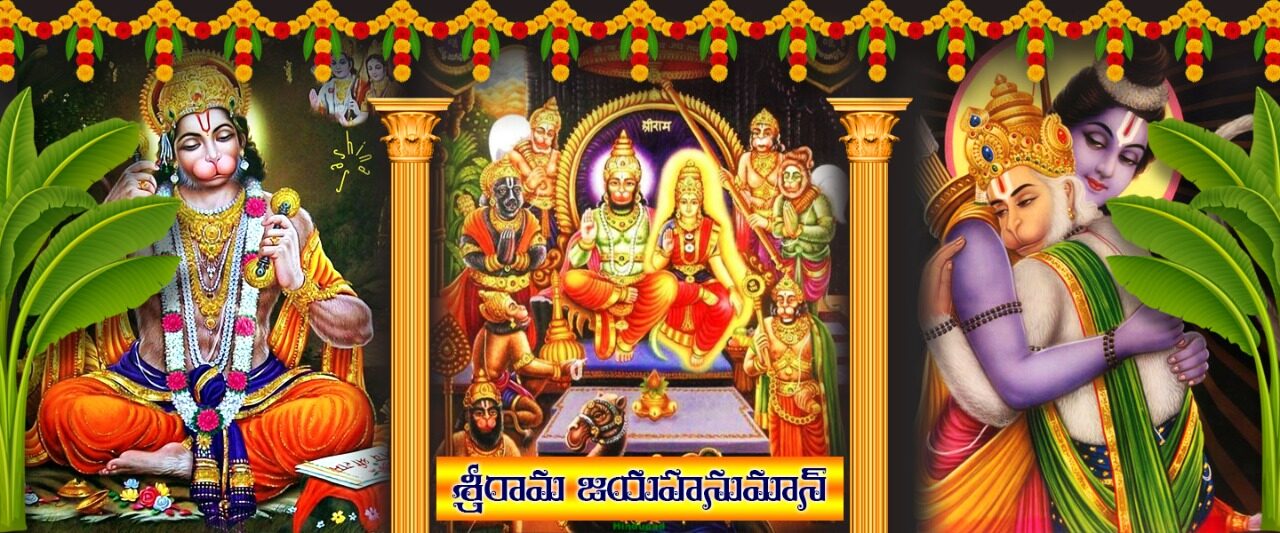
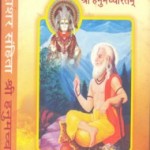


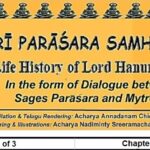
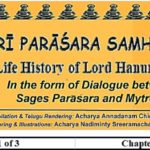

Be First to Comment